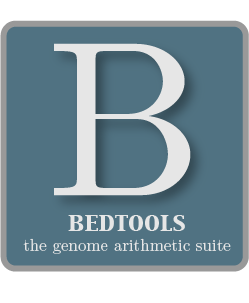7. Advanced usage¶
7.1. Mask all regions in a genome except for targeted capture regions.¶
Step 1. Add 500 bp up and downstream of each probe
bedtools slop -i probes.bed -b 500 > probes.500bp.bed
Step 2. Get a BED file of all regions not covered by the probes (+500 bp up/down)
bedtools complement -i probes.500bp.bed -g hg18.genome > probes.500bp.complement.bed
Step 3. Create a masked genome where all bases are masked except for the probes +500bp
bedtools maskfasta -in hg18.fa -bed probes.500bp.complement.bed -fo \
> hg18.probecomplement.masked.fa
7.2. Screening for novel SNPs.¶
Find all SNPs that are not in dbSnp and not in the latest 1000 genomes calls
bedtools intersect -a snp.calls.bed -b dbSnp.bed -v | \
bedtools intersect -a - -b 1KG.bed -v | \
> snp.calls.novel.bed
7.3. Computing the coverage of features that align entirely within an interval.¶
By default, bedtools coverage counts any feature in A that overlaps B by >= 1 bp. If you want to require that a feature align entirely within B for it to be counted, you can first use intersectBed with the “-f 1.0” option.
bedtools intersect -a features.bed -b windows.bed -f 1.0 | \
bedtools coverage -a - -b windows.bed \
> windows.bed.coverage
7.4. Computing the coverage of BAM alignments on exons.¶
One can combine samtools with bedtools to compute coverage directly from the BAM data by using bamtobed.
bedtools bamtobed -i reads.bam | \
bedtools coverage -a - -b exons.bed \
> exons.bed.coverage
Take it a step further and require that coverage be from properly-paired reads.
samtools view -uf 0x2 reads.bam | \
coverageBed -abam - -b exons.bed \
> exons.bed.proper.coverage
7.5. Computing coverage separately for each strand.¶
Use grep to only look at forward strand features (i.e. those that end in “+”).
bedtools bamtobed -i reads.bam | \
grep \+$ | \
bedtools coverage -a - -b genes.bed \
> genes.bed.forward.coverage
Use grep to only look at reverse strand features (i.e. those that end in “-”).
bedtools bamtobed -i reads.bam | \
grep \-$ | \
bedtools coverage -a - -b genes.bed \
> genes.bed.reverse.coverage
